23.03.2024

UFO-Forschung - ENHANCING SPACE SITUATIONAL AWARENESS TO MITIGATE RISK: A CASE STUDY IN THE MISIDENTIFICATION OF STARLINK SATELLITES AS UAP IN COMMERCIAL AVIATION -2
Fortsetzung2
Table 1. Summary of results from processing SOAP simulation extracted data with the route smoothing algorithm off. The output-analysis.xlsx excel spreadsheet provided on our GitHub site (see section 9 later in this paper) also includes data from when this SOAP algorithm was enabled.
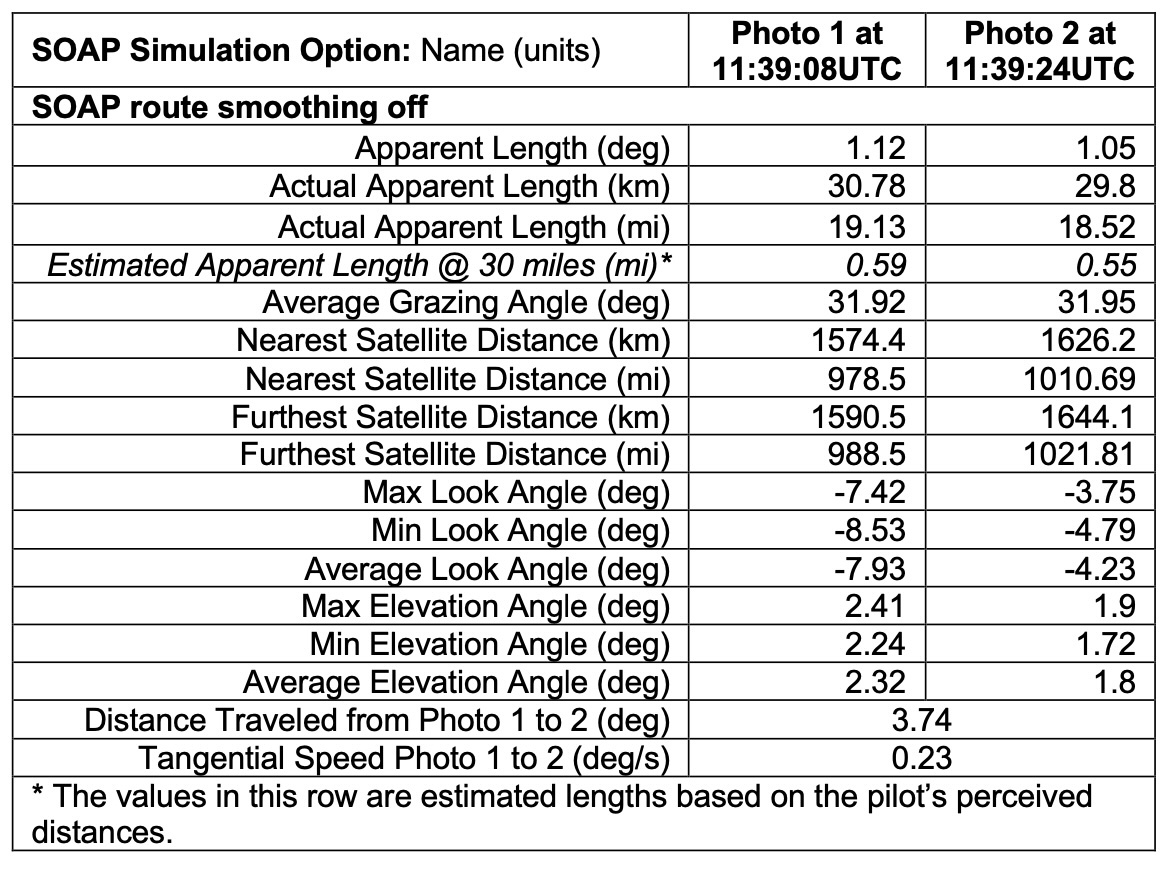
Table 2. Summary of results from processing SOAP simulation extracted data with an additional 2500 feet (0.8 km) added to the altitude to simulate an error in the aircraft’s altitude. Differences from the addition of the altitude error are shown below for each photo and simulation parameter.
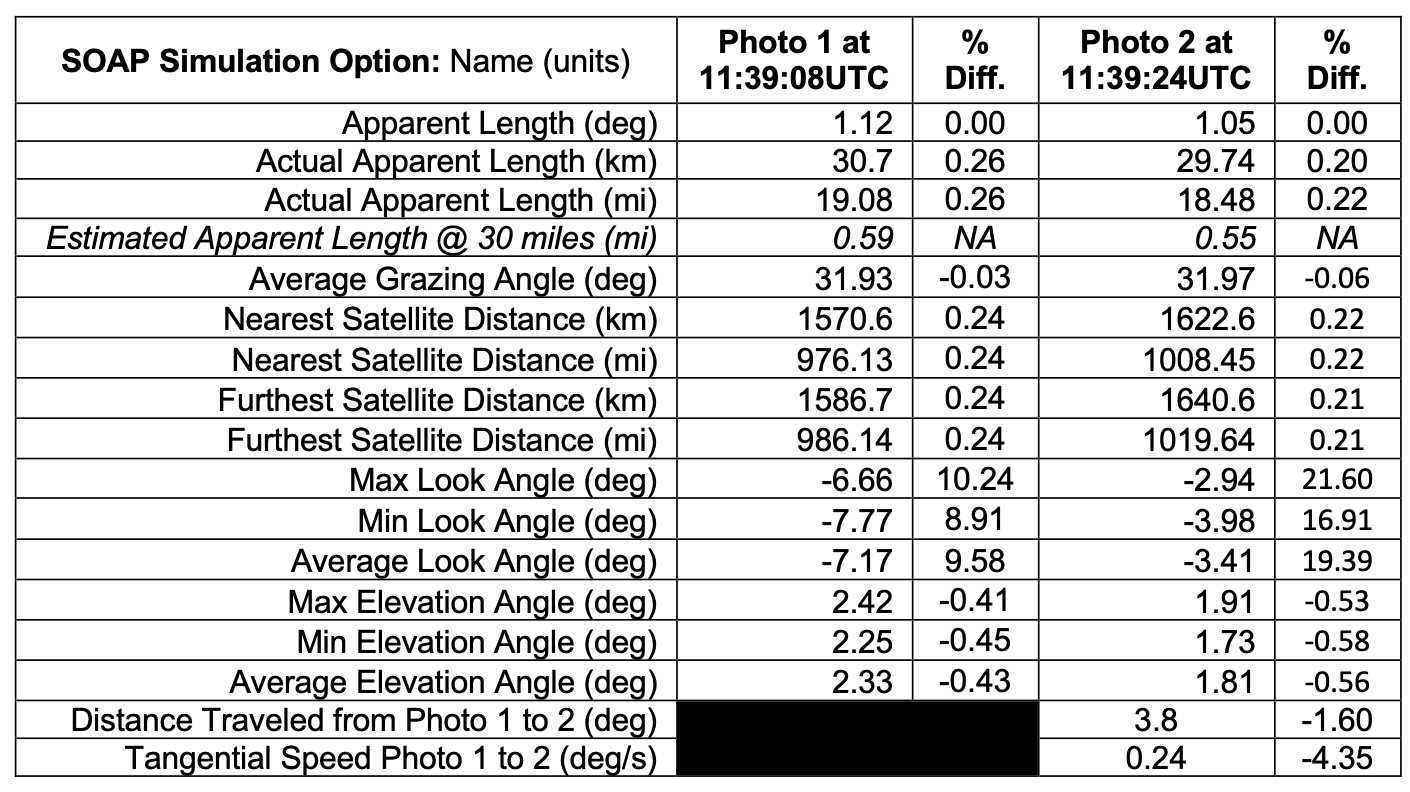
Using the location of the Starlink train we also plotted each satellite’s look angle and elevation angle against the Gemini star background at the UTC times of both photographs (Figure 18 and Figure 19) as an additional visual check on the location of the Starlink satellite train. These data were also used to calculate that the angular distance traveled between the photographs was 3.7 deg in 16 seconds.
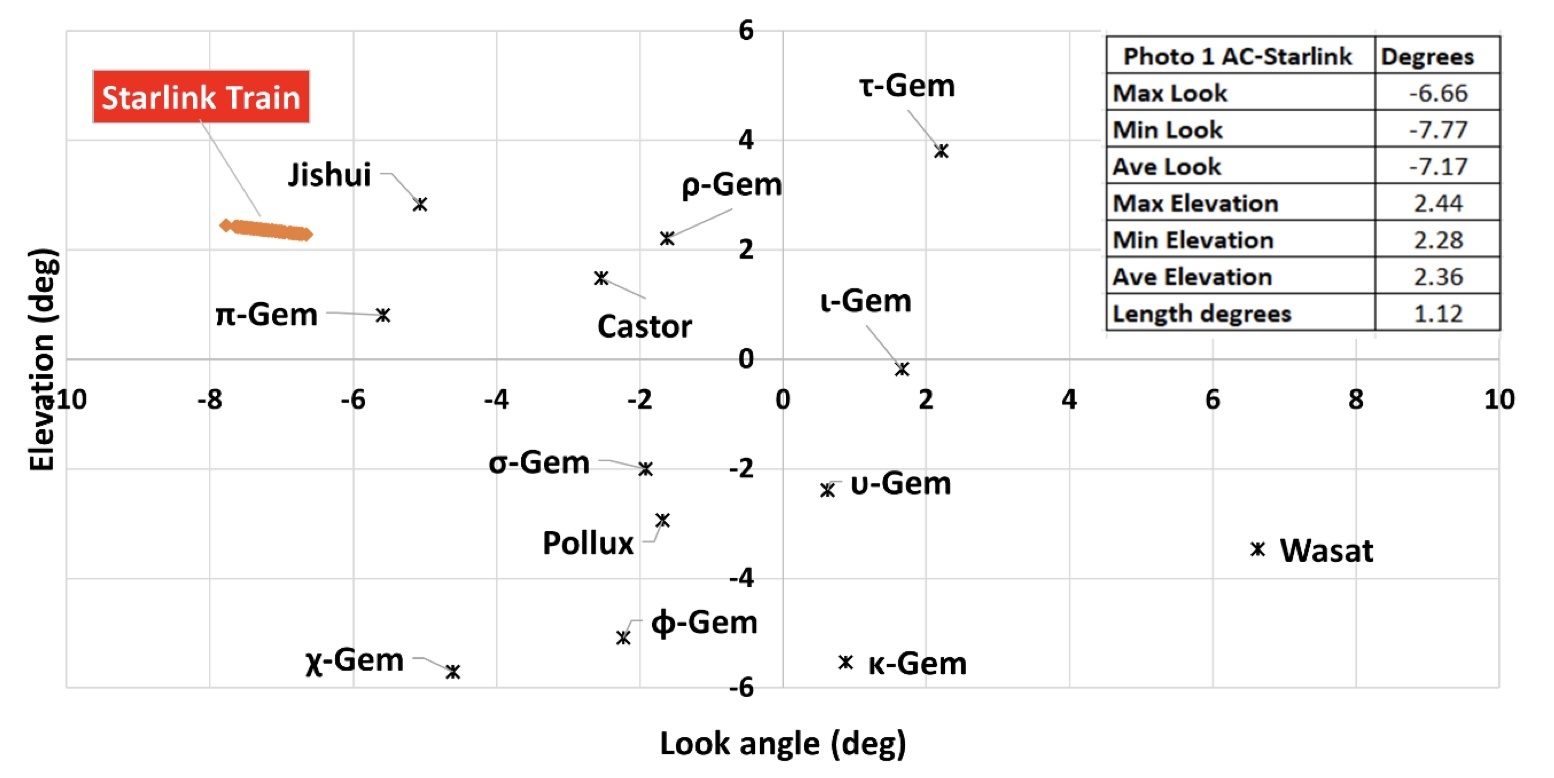
Figure 18. Microsoft® Excel® plot of the derived look and elevation angles for the satellite train at the time of Photo 1 with prominent Gemini stars included.24 Agrees with location in photograph.
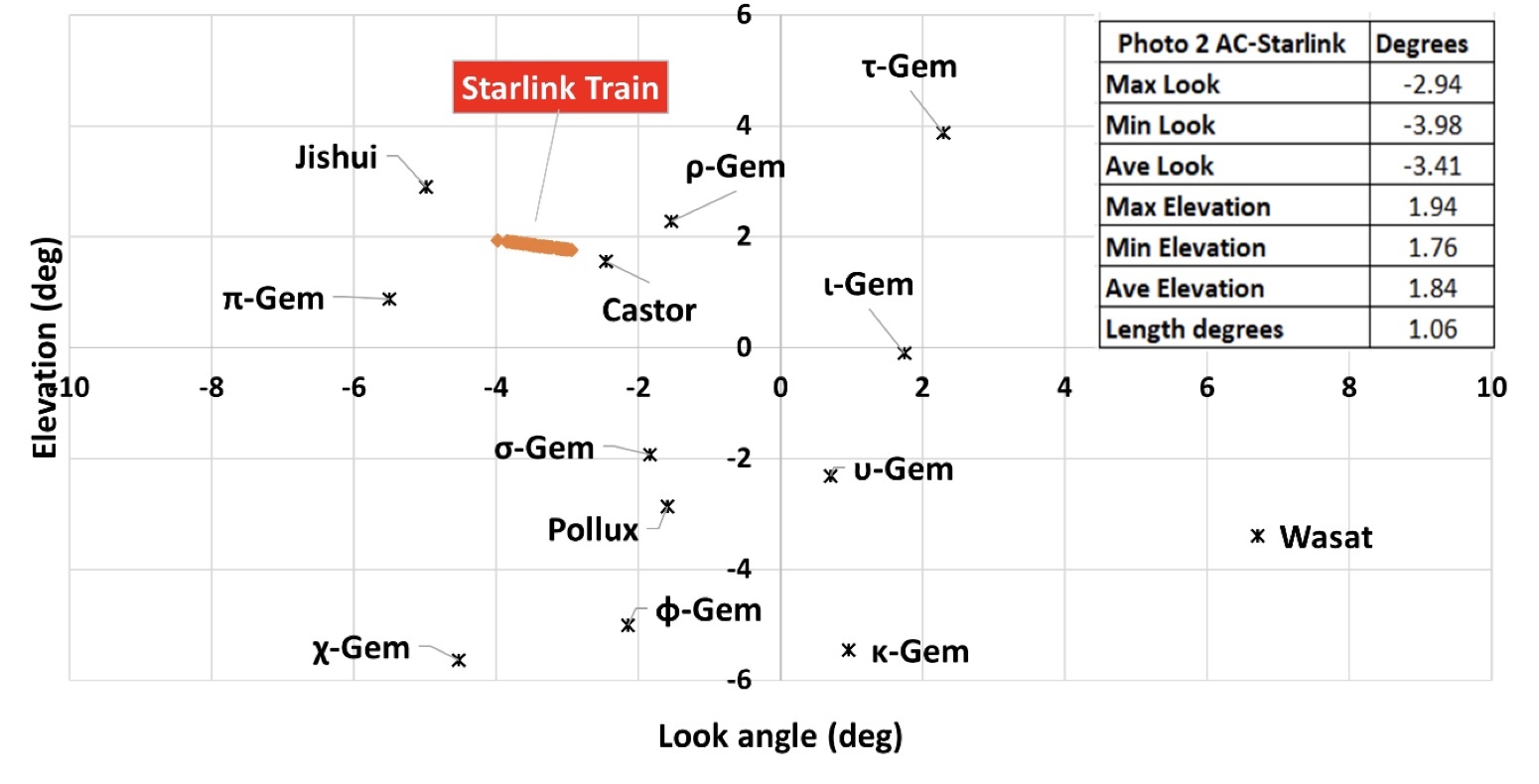
Figure 19. Microsoft® Excel® plot of the derived look and elevation angles for the satellite train at the time of Photo 2 with prominent Gemini stars included. Agrees with photograph.
The model predicts that the object would have a tangential angular speed of about 0.23 deg/s as viewed from the airplane, in close agreement with the case study results of 0.26 deg/s.
24 We used Mathematica® version 13.2 “ConstellationData” function to identify the Right Ascension and Declinations for bright stars in Gemini. These were converted into decimal degrees using Mathematica’s “FromDMS” function and rotated into aircraft look and elevation angle coordinates. The Mathematica Notebook and the Python function stars.py which converts far more stars into aircraft coordinates than are plotted are both available on our GitHub site.
4. Discussion
The analysis strongly suggests that this unidentified object is likely from an earlier SpaceX launch on August 10th, 2022, of version 1.5 Starlink satellites. The satellite train was crossing the day/night terminator at about 1620 km in distance from Air Canada flight (AC536) from which an anonymous pilot took photographs. Table 3 provides a comparison of the case study derived observables to the equivalent geometry derived values.
Table 3. Comparison of Case Study Derived Observables to Similar Geometry-based Values

The impact of Starlink satellites on astronomy has been known for some time (McDowell 2020, Girgis 2019, Cui and Xu 2022) as has their misidentification as UAP/UFOs (CBS Pittsburgh 2021, WCVB Channel 5 Boston 2023, Reyes 2023, Tangermann 2019, Grassi 2023, Mandelbaum 2019). After the impact on observational astronomy became known, SpaceX/Starlink and the astronomical community have been working to reduce the optical signatures of constellation satellites, with improvements to their next generation of Starlinks (v2.0 minis and v2.0) (Tangermann 2019), (Loeffler 2023), (SpaceX 2022), (S. S. Committee 2020), (S. S. Committee 2021), (Crider 2022). Froust at SPACENEWS has documented the ongoing history of this issue in these articles (Foust 2020, Foust 2023). In addition to Fankhauser, Tyson and Askari 2023, which characterizes how these airlines in the pacific were able to so clearly see these Starlinks, there are additional papers regarding the optical characteristics of Starlinks (Mallama, Hornig, et al. 2023, Mallama, Cole, et al. 2023).
A paper published on Starlink's API website (SpaceX 2022) includes a log-linear plot of the 'bidirectional reflectance distribution function' (BRDF) for the dielectric mirrors for the various generations of satellites, Figure 20.
The incident angle for the light source is at 60o which is equal to the reflection peak's angle. This geometry is similar to the BRDF angle that we calculated from the sun's grazing angle (see Table 1), i.e., the Sun’s grazing angle and the line-of-sight (LOS) angle from the satellite to the aircraft are nearly equivalent. It is worth noting that the 2nd generation of Starlink satellites continue to have significant specular reflections (Wikipedia 2023) from the same angle of incidence. Hence, we do not expect the new satellites to appreciably improve this issue while they are in the orbit boost phase with their solar arrays opened. SpaceX/Starlink appears to be fully aware of the specular reflection issue during their boost phase (Musk 2020). As Musk indicated, one option for dealing with the specular reflection peak is to re-orient the satellites during the orbit boost phase as they are crossing the day/night terminator (see for example pg. 6 in (Musk 2020) and (SpaceX 2020)). This reorientation of their "open-book" configuration would not have the solar arrays and satellite “flat to the earth” and would instead redirect the sun’s light back out into space.
25 Deciding that Blender is not the correct tool to properly estimate this quantity, we’ve decided to defer an attempt to render the apparent magnitude for future work using OpenSpace.
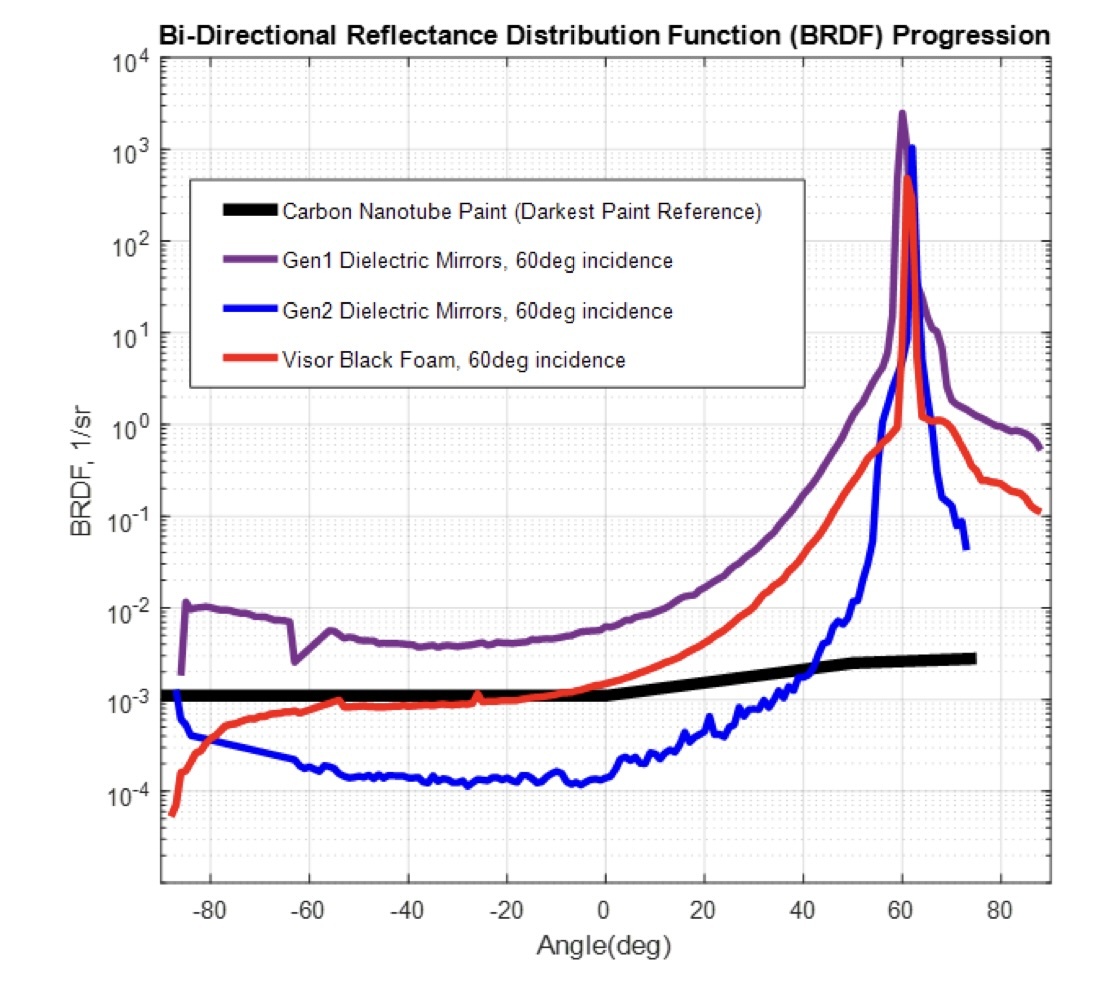
Figure 20. The Progression of the 'bidirectional reflectance distribution function' (BRDF) from two generations of Starlink satellite dielectric mirrors. Note the significant specular reflection spike at 60 degrees with an incident angle from the light source of 60 degrees.
Source: SpaceX (SpaceX 2022)
Another would be to include a sunshade that is deployed to reflect the sun back into space when in this orientation. However, knowing that SpaceX had experimented with a “sun visor” option (Foust 2020), all we really know is that this option was abandoned because it would not solve astronomy’s problem (McFall-Johnsen 2020).
A very recent Starlink train of 22 v2.0 minis (Schrader 2023) was uploaded to YouTube (LIVE 2023) clearly showing the train of Starlinks as they transited across the day/night terminator. This suggests that a re-orientation attitude maneuver has yet to be implemented. We speculate that this may be due to issues associated with attitude control, presumably using the satellite’s reaction wheels or attitude control thrusters, or perhaps some other issue. Either way, we are unaware of any statements from SpaceX or Musk as to when a reorientation maneuver will be implemented or that it has been abandoned as an option.
5. ConclusionsandRecommendations
We described a methodology that uses orbital simulation software with aircraft ADS- B location data and a satellite's ephemeris data from supplemental versions of NORAD's Two-Line Elements (TLEs). We initially used The Aerospace Corporation's Satellite Orbital Analysis Program (SOAP) to verify the locations of the STARLINK Group 4-26 satellites, but as this software is only available to employees of Aerospace and their U.S. government customers, we also enlisted the support of students enrolled in a University of Utah Space Mission Engineering course to use model the Starlink train's location in orbit using the commercial orbital analysis package, System Tool Kit (STK) from Ansys.
Images extracted from both simulations clearly show that deploying satellites in Starlink Group 4-26 were in the same location of the sky at the time the photographs were taken. Our analysis also suggests that there are information gaps and software visualization issues that kept us from providing identical renderings of the satellites as seen by the images in the photographs. First, we had to make assumptions regarding the deployment status and orientation of the satellites at the time of the photographs. The case study suggested star-like objects merged into a single larger craft-like object. This could be explained by solar array deployments or changes in the viewing geometry. Hence, we consider that knowing the status of each of the satellite's solar arrays with respect to the satellite’s attitude and orbit location over time is critical information.
Therefore, we recommend that satellite operators either unilaterally provide planned spacecraft/satellite attitude orientation, orbit location and deployment timeline, or the government should require this information. With this information, models for what the spacecraft would look like to observers on the ground or in aircraft could be developed. Especially for ground-based observers, weather/cloud coverage predictions would be necessary for observability predictions.
Second, our approach attempted to couple orbital modeling with rendering using POV ray tracing of the satellite train for a viewer in the cockpit of the aircraft that had photographs. However, we found it difficult using the selected software to provide dependable rendering results using the sun as the illumination source, so we simply tried rendering the satellites as emission sources at the correct distances from the satellites to the aircraft. This difficulty is discussed in the next section of this paper. However, the results suggest that the satellite train likely had their solar arrays deployed which likely made them visible to the pilots from the additional area for specular reflection from the sun to be directed at these aircraft.
Finally, we firmly believe that the Federal Aviation Administration (FAA) could easily reduce the risk to the flying public from pilots engaging in airwave chatter (Hansen 2024) trying to figure out what they are seeing by placing this modeling capability in the hands of air traffic controllers after carefully thinking through a system architecture for this additional modeling capability. We envision this as a collaborative effort between the satellite’s owners (in this case SpaceX/Starlink), the FAA, NASA, NOAA, and the U.S. Space Force.
6. FutureWork
Investigating alternative rendering software is the most obvious capability we (or others) need to investigate in future work. Specifically, the observability of the deployment of these constellations with respect to solar, earth and lunar illumination angles is the most important next step where we believe OpenSpace is the right tool. However, one of us elected to use (Blender 2024) for this purpose due to its price (free), capabilities, and support community even though it is primarily used by the animation community, and the rest of us felt due to our time constraints was a sufficient modeling tool.
Finally, we anticipate that a properly architected solution for the FAA would allow them to provide notices to aviators regarding the visibility of satellites. Eventually, the ability to provide tablet or cellphone simulation results to the aviation community and the public would help provide advanced notification for what these space events should look like under specific viewing conditions. To do the modeling correctly, the simulation models will need the following information to provide aviators and the public situational awareness,
Our preferred list of required information (where a indicates the data or information exists, and indicates that either the data or information does not exist, we are not aware of its publicly accessible existence, or it is not usable in its current form) for each launch of satellites would include:26,27
-
– the launch window in Coordinated Universal Time (UTC)
Spaceflight Now (Spaceflight Now 2024) and others
NASA Space Flight (NASA Space Flight 2024)
RocketLaunch.Live (RocketLaunch.Live 2024) and others
predictive supplemental TLE's from Celestrak and Space-Track.org -
– orbit boost timelines for each satellite
predictive supplemental TLE's provided to Celestrak and Space-Track.org -
– launch debris orbit decay predictions
TLE's from Celestrak and Space-Track.org -
– attitude dynamics
orientation plans/models for debris and spacecraft with deployment (solar arrays, antennas) timelines (not provided)
-
– other items required to properly model these events
dynamic Computer Aided Design (CAD) models of the exterior of the spacecraft with materials and their properties (e.g. BRDF) (not provided directly, however, some hobbyist models are available)
weather forecast - in particular cloud coverage at various altitudes, (NOAA)
-
software and algorithms to accumulate the above to provide simulations to aviators and ground observers - observability predictions (use STK or other software, where additional examples are NASA Worldwind (NASA 2023), and Google Earth (Google LLC 2023))
-
software to provide renderings for aircraft and ground observers (exploring OpenSpace is a research goal)
-
sufficient computational resources to provide results in a timely manner (use cloud-based computing provider)
-
sighting reporting/identification software for cell phones and tablets (some cellphone-based apps exist, such as SIGHTER.io (SIGHTER 2023) and Enigma Labs, LLC (ENIGMA 2023) but as of the time this paper was released did not provide predictive capabilities for aerospace phenomena)
26 Potential national security restrictions could require some launches to remain obscured in secrecy. 27 We use ato indicate that a known information source exists, andto indicate that no known information source exists, or that this is a capability that has not yet been developed.
We believe this approach would help remove a significant fraction of known space- related events from being mischaracterized and misreported as UAP.
7. Acknowledgments
The authors would like to thank the pilots of AC536 for the photographs and their eyewitness accounts of the sighting, as well as the pilots of AC34 for their corroborating eyewitness accounts without which this paper would not have been possible. We are grateful to Mick West of Metabunk.org for recognizing that the object seen by the aircraft pilots was a train of recently-launched Starlink satellites and not a UAP. We would also like to thank Dr. T.S. Kelso for the query to extract all the Starlinks from Group 4-26 supplemental TLEs and Dr. Jonathan McDowell for providing relevant supplemental TLEs and information during the initial research phase of this work. We would like to thank Ben Hansen for his insights into the flight safety issue these reports are causing for the aviation industry, and Dr. T.S. Kelso’s support with supplemental TLEs and his review comments. We especially want to thank the Scientific Coalition for UAP Studies science advisor, Dr. Sarah Little, for ADS-B data for the flights and several extremely helpful review comments and suggestions that have been provided during this research. Richard Griffiths acknowledges the support of MUFON for access to the observational sighting report and for discussions relating to the nature of the observed images and video.
8. ConflictofInterestStatement
Two of the authors (Buettner and Griffiths) are consultants for SIGHTER.io, one of the known cell phone apps created to crowd source observations of possible UAP sightings.
9. SupplementaryMaterials
We list here our supplementary materials and methods archived online.
1. A GitHub website with materials used in this research and screenshots of SOAP modeling results is available at (DrDougB 2024):
In the “root” directory:
-
README.md: standard GitHub description of the archive
-
1st_photo.zip: is a zip archive of the SOAP extracted ephemerides and the csvout processed comma delimited format files for SOAP at the same UTC time as photo 1 was taken. The ouput.csv file is the final processing from the cockpitview.py python script for photo 1.
-
2nd_photo.zip: is a zip archive of the SOAP extracted ephemerides and the csvout processed comma delimited format files for SOAP at the same UTC time as photo 2 was taken. The ouput.csv file is the final processing from the cockpitview.py python script for photo 2.
-
AC536.xlsx: AC536 ADS-B data processed to extract location data for SOAP.
-
AC536_2d008340 _alice_rg.csv.kmz: AC536 ADS-B data provided by the Scientific Coalition for UAP Studies’ scientific advisor which was used to create the AC536.xlsx file.
-
Constellation-bright stars.nb: Mathematica® notebook used to obtain star RA and Declinations which were transformed into cockpit view coordinates.
-
Final STK Files.zip: is a zip archive of the final STK model used in this paper.
-
McDowell's RAW TLE 'like' dump.zip: is the zip archive for Jonathan McDowell’s Starlink dump which supported early modeling prior to modifications by T.S. Kelso to Celestrak.
-
STARLINK-8-10.tle: The full list of TLEs for the Group 4-26 Starlink TLEs that were extracted from T.S. Kelso’s full TLE supplemental TLE query. These TLEs represent the closest UTC times to the UTC times from both photographs.
-
cockpitview.py: is the Python script used to create our final cockpit view coordinates.
-
csvout.py: Python script used to process the SOAP extracted data into the comma delimited format.
-
geoid_height_2023-08-09.csv: Geoid heights from reference (EarthScope Consortium 2023).
-
group4-26.zip: is a zip archive of Celestrak’s supplemental query results.
-
output-analysis.xlsx: is an Excel® spreadsheet with our final analysis results.
-
relative.py: is a Python script that was initially created to process the csv files, was replaced by cockpitview.py.
-
rot.py: is a Python script with the coordinate transformation rotations from Vallado (Vallado 2013).
-
sidereal.py: from Michael Hirsch’s Python 3-D coordinate conversion code (https://github.com/geospace-code/pymap3d) to support translation of stellar coordinates to the cockpitview coordinate system.
-
star_output.csv: the output file from stars.py.
-
stars.py: my cobbled together python code to create the star_output.csv file which provides stellar coordinates in the cockpitview coordinate system.
-
vallado.py: from Michael Hirsch’s Python 3-D coordinate conversion code (https://github.com/geospace-code/pymap3d) to support translation of stellar coordinates.
In the “SOAP screenshots” subdirectory:
-
readme.txt: current list of files and the below description of the movie file
-
Screenshot 2023-12-25 065808.png: screengrab of a SOAP sim result
-
Screenshot-Photo 1 Cyl Equal Area.png: screengrab of a SOAP sim result
-
Screenshot-Photo 1 Geometry.png: screengrab of a SOAP sim result
-
Screenshot-Photo 1 Sun2Earth.png: screengrab of a SOAP sim result
-
Screenshot-Photo 2 Cyl Equal Area.png: screengrab of a SOAP sim result
-
Screenshot-Photo 2 Geometry.png: screengrab of a SOAP sim result
-
Screenshot-Photo 2 Sun2Earth.png: screengrab of a SOAP sim result
-
Photo 1 Cyl Equal Area-zoom insert.png: screengrab of a SOAP sim result
-
Photo 1 Cyl Equal Area-zoom.png: screengrab of a SOAP sim result
-
Photo 1 Geometry-zoom.png: screengrab of a SOAP sim result
xii. Photo 1 UTC time with an added alt error (Fig-6).png: screengrab of a SOAP sim result where 2500 feet (0.8 km) was added to the aircraft’s altitude
xxi. Photo 2 UTC time with an added alt error.png: screengrab of a SOAP sim result where 2500 feet (0.8 km) was added to the aircraft’s altitude
2. AdditionalvideosandscreenshotsofoursimulationsareavailableonGoogle Drive at (Buettner, et al. 2024):
In the “Movies” subdirectory:
-
README.txt: current list of files and the below description of the movie file.
-
STK-SatelliteDeployment.mp4: STK simulation of launch through deployment.
-
STK-StationarySatelliteFlyBy.mp4: STK simulation of location of Starlink Train w/ respect to a stationary aircraft.
-
STK-SatelliteFlyByV2.mp4: STK simulation of the FULL location of Starlink Train w/ respect to the aircraft.
-
SOAP-AC536-Earth-Sun_movie.wmv: SOAP Earth Polar view showing AC536, G4-26, and the location of the sun-Left, and our standard Earth Ground - Perspective with AC536 in the center with the satellite train G4- 26 and the constellations in the background. The atmospheric glow from the sun is displayed as well.
-
SOAP-AC536-Earth-Sun_with altitude error movie.wmv: SOAP earth, sun, AC536 perspective with the G4-26 satellite train and ground tracks. The solar terminator is viewed on the edge of the earth's limb and constellations on the left. Our standard Earth Ground - Perspective with AC536 in the center with the satellite train G4-26 and the constellations in the background on the right.
-
SOAP-AC536-perspective.wmv: SOAP standard Earth Ground - Perspective with AC536 in the center with the satellite train G4-26 and the constellations in the background. The atmospheric glow from the sun is displayed as well.
-
SOAP-AC536-perspective-movie.wmv: SOAP polar view with the AC536, the ADS-B ground track, and the location of G4-26 on the left, and the standard Earth Ground - Perspective with AC536 in the center with the satellite train G4-26 and the constellations in the background on the right, this time with the AC536 ground track
In the “Blender” subdirectory:
-
Blender Rendering Experiments.zip: is a zip archive of the rendering experiments attempted in this paper (the archive includes all the .blend and .blend1 files with the Boeing CAD model and surrogate ‘cubes’ for all 52 Starlinks for Blender 4.0.1 and the Earth TIFF file that we used)
-
Blender Rendering Experiments-images.zip: is a zip archive of our rendering results with other screengrabs of settings and cockpit view location)
-
-
10. References
117th Congress (2021-2022). 2022. "Unidentified Aerial Phenomena (Open and Closed) ." May 17. Accessed January 23, 2024. https://www.congress.gov/event/117th- congress/house-event/114761?s=1&r=4.
Aerospace. 2020. What is Aerospace's Satellite Orbit Analysis Program (SOAP)? November 16. Accessed January 23, 2024. https://www.youtube.com/watch?v=nq_q5Qh2lBE.
AGI/ANSYS. 2024. Ansys STK. Accessed March 9, 2024. https://www.agi.com/products and https://www.ansys.com/products/missions/ansys-stk [Accessed August 24, 2024].
blender. 2024. Blender 4.0. Accessed March 9, 2024. https://www.blender.org/. —. 2023. Rendering. Accessed March 9, 2024.
https://www.blender.org/features/rendering/ .
Blender. 2023. Rendering: Rendering and Beyond. Accessed March 10, 2024.
https://www.blender.org/features/rendering/ .
Buettner, Douglas J., Richard E. Griffiths, Nick Snell, and John Stilley. 2024. Starlink
Group 4-26. 2024 10. Accessed March 10, 2024. https://drive.google.com/drive/folders/1t6ce_TaUQnk8pF1KTLSTpmVcLDZb6v 1d?usp=drive_link .
CBS Pittsburgh. 2021. Starlink Satellites Mistaken As UFOs Over Pittsburgh. December 5. Accessed January 23, 2024. https://www.youtube.com/watch?v=1sMvdE8MfgA. Committee, SATCON1 Scientific Organizing. 2020. "Satellite Constellations 1 (SATCON1)
workshop." Satellite Constellations 1 Workshop Report.
https://aas.org/sites/default/files/2020-08/SATCON1-Report.pdf.
Committee, SATCON2 Scientific Organizing. 2021. "Satellite Constellations 2 (SATCON2)
Workshop." SATCON2 Working Group Reports. doi:10.5281/zenodo.5608820. Crider, Johnna. 2022. SpaceX shares how it’s making Starlink satellites less bright.
TESLARATI.com,. July 30. Accessed February 7, 2024. https://www.teslarati.com/spacex-shares-how-its-making-starlink-satellite- less-bright/.
C-SPAN. 2023. "Hearing on Unidentified Aerial Phenomena." July 26. Accessed January 23, 2024. https://www.c-span.org/video/?529499-1/hearing-unidentified- aerial-phenomena.
David, Leonard. 2023. Scientists Try to Get Serious about Studying UFOs. Good Luck with That. Sci Am. February 6. Accessed January 23, 2024. https://www.scientificamerican.com/article/scientists-try-to-get-serious-about- studying-ufos-good-luck-with-that/.
DrDougB. 2024. Starlink_G4-26. March 10. Accessed March 10, 2024. https://github.com/DrDougB/Starlink_G4-26.
Dunn, Marcia. 2023. WATCH: NASA report says more science and less stigma are needed to understand UFO sightings. PBS News Hour. September 14. Accessed January 23, 2024. https://www.pbs.org/newshour/science/watch-nasa-report-says- more-science-and-less-stigma-are-needed-to-understand-ufo-sightings.
Dustin Lang et al. 2010. "ASTROMETRY.NET: BLIND ASTROMETRIC CALIBRATION OF ARBITRARY ASTRONOMICAL IMAGES." The Astronomical Journal 139, 5 (1782). doi:10.1088/0004-6256/139/5/1782.
EarthScope Consortium. 2023. "Geoid Height Calculator, Geodetic Facility for the Advancement of Geoscience (GAGE)." May 16. Accessed January 23, 2024. https://www.unavco.org/software/geodetic-utilities/geoid-height- calculator/geoid-height-calculator.html.
ENIGMA. 2023. ENIGMA: The Trusted Destination for UAP SIghtings. Accessed March 10, 2024. https://enigmalabs.io/.
Fankhauser, F., J. A. Tyson, and J. Askari. 2023. "Satellite Optical Brightness." The Astronomical Journal 166 (59): 12. doi:10.3847/1538-3881/ace047.
Forrest, Andrew. 2020. What are the dimensions of a Starlink satellite compared to existing internet satellites? Quora.com. July 8. Accessed March 10, 2024. https://www.quora.com/What-are-the-dimensions-of-a-Starlink-satellite- compared-to-existing-internet-satellites.
Foust, Jeff. 2023. NSF and SpaceX reach agreement to reduce Starlink effects on astronomy. SPACENEWS. January 12. Accessed February 7, 2024. https://spacenews.com/nsf-and-spacex-reach-agreement-to-reduce-starlink- effects-on-astronomy/.
—. 2020. SpaceX to test Starlink “sun visor” to reduce brightness . SPACENEWS. April 27. Accessed February 7, 2024. https://spacenews.com/spacex-to-test-starlink-sun- visor-to-reduce-brightness/.
—. 2020. Starlink vs. the astronomers. SPACENEWS. February 4. Accessed February 7, 2024. https://spacenews.com/starlink-vs-the-astronomers/.
Girgis, Victoria. 2019. Trails made by Starlink satellites. Lowell Observatory. June 3 . Accessed February 7, 2024.
https://www.iau.org/public/images/detail/ann19035a/.
Goo, Isidor. 2022. Boeing 737 MAX-9. June 23. Accessed March 9, 2024.
https://sketchfab.com/3d-models/boeing-737-max-9-
2e3bdccfa5b9489b98be1fcaa6628930.
Google LLC. 2023. Google Earth. Accessed March 10, 2024.
https://earth.google.com/web.
Grassi, Rose. 2023. String of lights over NJ thought to be UFOs, go viral on social media.
NBC 10 Philadelphia. September 16. Accessed January 23, 2024. https://www.nbcphiladelphia.com/news/local/string-of-lights-over-nj-thought- to-be-ufos-go-viral-on-social-media/3647588/.
Graves, Ryan. 2023. Ryan “FOBS” Graves Testimony at the Hearing on Unidentified Anomalous Phenomena: Implications on National Security, Public Safety, and Government Transparency, before the House Oversight Subcommittee on National Security, the Border, and Foreign Affairs. U.S. House of Representatives Oversight Subcommittee on National Security, the Border, and Foreign Affairs. July 26. Accessed January 23, 2024. Video of testimony: https://youtu.be/KQ7Dw-739VY and written testimony: https://oversight.house.gov/wp- content/uploads/2023/07/Ryan-HOC-Testimony.pdf.
Hoots, Felix R.,. Roehrich, Ronald L. 1988. "SPACETRACK REPORT NO. 3: Models for Propagation of NORAD Element Sets." USAF. December 31. Accessed January 23, 2024. https://celestrak.org/NORAD/documentation/spacetrk.pdf.
IAU and Sky & Telescope. 2015. Gemini. January 14 . Accessed March 9, 2024. https://www.iau.org/public/images/detail/gem_new/.
IAU and Sky & Telescope magazine. n.d. The Constellations. International Astronomical Union. Accessed January 27, 2024. https://www.iau.org/public/themes/constellations/#n6.
Kelso, T. S. 2022. Celestrak's Two Line Elements for Starlink Group 4-26. CelesTrak. August 15. Accessed March 9, 2024. https://celestrak.org/NORAD/elements/gp- first.php?INTDES=2022-097.
—. 2022. How to Perform SupGP Queries. July 15. Accessed March 9, 2024. https://celestrak.org/NORAD/documentation/sup-gp-queries.php.
—. 2024b. NORAD SupGP Data Sets Historical Archives. March 9. Accessed March 9, 2024. https://celestrak.org/NORAD/archives/sup-request.php?FORMAT=tle.
—. 2022. NORAD SupGP Data Sets Historical Archives Special Data Request Form. CelesTrak. October 6. Accessed January 23, 2024. https://celestrak.org/NORAD/archives/sup-request.php.
—. 2022. NORAD Two-Line Element Set Format. CelesTrak. July, 1. Accessed January 23, 2024. https://celestrak.org/NORAD/documentation/tle-fmt.php.
—. 2023. "private communication."
—. 2024a. Satellite Catalog (SATCAT): Raw SATCAT Data CSV. March 9. Accessed March
9, 2024. https://celestrak.org/pub/satcat.csv.
Lang, Dustin. 2023. "private communication."
LIVE, Asahi Astro. 2023. Merry Christmas 2023 with starlink train 6-32. Asahi Shimbun
Space Department. December 24. Accessed January 24, 2024.
https://youtu.be/2zwTlDKxErE.
Loeffler, John. 2023. SpaceX and astronomers come to agreement on reducing Starlink
astronomy impact. Space.com. January 26. Accessed January 23, 2024. https://www.space.com/spacex-starlink-astronomy-impact-reduction- agreement.
Lomas, Tim. 2023. "A global picture of unidentified anomalous phenomena: Towards a cross-cultural understanding of a potentially universal issue." International Social Science Journal 29.
Mallama, Anthony, Andreas Hornig, Richard E. Cole, Scott Harrington, Jay Respler, Ron Lee, and Aaron Worley. 2023. "Assessment of Brightness Mitigation Practices for Starlink Satellites." October 3. Accessed February 7, 2024. https://arxiv.org/abs/2309.14152.
Mallama, Anthony, Richard E. Cole, Scott Harrington, Andreas Hornig, Jay Respler, Aaron Worley, and Ron Lee. 2023. "Starlink Generation 2 Mini Satellites: Photometric Characterization." arXiv. June 11. Accessed February 7, 2024. https://arxiv.org/abs/2306.06657.
Mandel, W. A. Joye and E. 2003. "New Features of SAOImage DS9." Astronomical Data Analysis Software and Systems XII, ASP Conference Series, Vol. 295,.
Mandelbaum, Ryan F. 2019. Starlink Satellites Produce Wave of UFO Sightings in the US. GIZMODO. December 27. Accessed January 23, 2024. https://gizmodo.com/starlink-satellites-produce-wave-of-ufo-sightings-in-th- 1840678429.
McDowell, Jonathan C. 2020. "The Low Earth Orbit Satellite Population and Impacts of the SpaceX Starlink Constellation." The Astrophysical Journal Letters 892 (L36): 1-10. https://iopscience.iop.org/article/10.3847/2041-8213/ab8016/pdf.
McFall-Johnsen, Morgan. 2020. SpaceX just launched 57 new Starlink satellites with sun visors to make them less bright. A scientist says that won't stop them from interfering with astronomy. Business Insider. August 7. Accessed February 7, 2024. https://www.businessinsider.com/spacex-starlink-sun-shades-visors-cut- reflection-telescope-problems-remain-2020-8.
Medina, R. M., Brewer, S. C., and Kirkpatrick, S. M. 2023. "An environmental analysis of public UAP sightings and sky view potential." Sci Rep 13 (22213): 9. Accessed January 23, 2024. doi:10.1038/s41598-023-49527-x.
Musk, Elon. 2020. STARLINK: NAS DECADAL PANEL. Decadal Survey on Astronomy and Astrophysics 2020 (Astro2020): Optical Interference from Satellite Constellations Meeting. April 27. Accessed February 7, 2024. https://www.nationalacademies.org/event/04-27- 2020/docs/DA41D1DEC885471C4F9D12AD7CEF7C5DB4504FEEC7BD?noSave As=1.
NASA. 2004. August, Blue Marble Next Generation. August 1. Accessed March 9, 2024. https://visibleearth.nasa.gov/images/74117/august-blue-marble-next- generation.
—. 2023. NASA Worldwind. April 5. Accessed March 10, 2024. https://worldwind.arc.nasa.gov/.
OpenSpace Team. 2023. OpenSpace. Accessed March 9, 2024. https://www.openspaceproject.com/.
Pittet. 2023. "unknown." Canadian Aviator.
PrinceNightTTV. 2021. Elon Musk at Astro2020. Reddit. November 4. Accessed February
7, 2024. https://www.reddit.com/r/spacex/comments/g96v3h/elon_musk_at_astro2020 /?rdt=44161.
reddit users. 2023. Stralink FAQ: What do we know about the satellites? Reddit r/Starlink . May 22. Accessed February 14, 2024. https://www.reddit.com/r/Starlink/wiki/faq/#wiki_- _what_do_we_know_about_the_satellites.3F.
Reyes, Ronny. 2023. New Jersey UFO scare turns out to be Elon Musk Starlink satellite launch. New York Post. September 17. Accessed January 23, 2024. https://nypost.com/2023/09/17/elon-musks-starlink-satellite-launch-causes- ufo-scare-in-new-jersey/.
RocketLaunch.Live. 2022. Starlink-54 (4-26). August 9. Accessed March 9, 2024. https://www.rocketlaunch.live/launch/starlink-54-4-26.
S. Narayanan, and O. Osechas. 2022. "Enhanced Vertical Navigation Using Barometric Measurements." Sensors, Special Issue Sensors in Aircraft 22 (23): 22. doi:10.3390/s22239263.
Schrader, Adam. 2023. SpaceX launches Starlink, Sarah-2 missions. UPI Science News. December 24. Accessed January 23, 2024. https://www.upi.com/Science_News/2023/12/24/spacex-launches-starlink- sarah-2-missions/3111703432700/.
Schwartz, Gadi. 2022. Pilot Shares Videos Of Strange UFO Sightings In Skies Over The US. NBC's Today Show. October 21. Accessed January 23, 2024. https://youtu.be/iT9BtWCBbic.
Sesnic, T. 2022. Starlink Group 4-26 | Falcon 9 Block 5. Every Day Astronaut. August 10. Accessed January 23, 2024. https://everydayastronaut.com/starlink-group-4- 26-falcon-9-block-5-2/.
Sharps, Matthew J. 2023. Psychology and the Flying Saucer People: UAPs and UFOs may be psychological rather than physical phenomena. Psychology Today. June 5. Accessed January 23, 2024. https://www.psychologytoday.com/us/blog/the- forensic-view/202305/psychology-and-the-flying-saucer-people.
SIGHTER. 2023. SIGHTER: CONNECTED-GLOBAL-FOCUSED. Accessed March 10, 2024. https://sighter.io/.
SpaceX. 2022. "BRIGHTNESS MITIGATION BEST PRACTICES FOR SATELLITE OPERATORS." July. Accessed January 23, 2024. https://api.starlink.com/public- files/BrightnessMitigationBestPracticesSatelliteOperators.pdf.
2022. SpaceX shares how it’s making Starlink satellites less bright. TESLARATI.com,. j. SpaceX. 2020. SpaceX Updates: Article "Astronomy Discussion with National Academy of
Sciences". SpaceX. April 28. Accessed February 7, 2024.
https://www.spacex.com/updates/.
Sultan, Kamal. 2023. Commercial pilots were told not speak publicly about UFOs and had
their jobs threatened, expert says. Dailymail.Com. July 27. Accessed January 23, 2024. https://www.dailymail.co.uk/news/article-12342921/Commercial-pilots- told-superiors-not-speak-publicly-mysterious-sightings-threatened-losing-jobs- reported-expert-claims.html.
Tangermann, Victor. 2019. People Keep Mistaking SpaceX’s Satellites for Alien Spacecraft. The Byte. December 17. Accessed January 23, 2024. https://futurism.com/the- byte/spacex-starlink-satellites-ufos.
—. 2019. SpaceX: We're Working to Fix Sky-Killing Starlink Satellites "We want to make sure we do the right thing to make sure little kids can look through their telescope.". The Byte. December 9. Accessed January 23, 2024. https://futurism.com/the-byte/spacex-fix-sky-killing-starlink-satellites.
Tim Gallaudet, Ph.D., and Christopher Mellon. 2023. The ocean science community must put science before stigma with anomalous phenomena. The Hill. September 14. Accessed January 23, 2024. https://thehill.com/opinion/technology/3853227- the-ocean-science-community-must-put-science-before-stigma-with-anomalous- phenomena/.
Torre, Gabriel G. De la. 2024. "Psychological aspects in unidentified anomalous phenomena (UAP) witnesses." International Journal of Astrobiology 23 (e4). doi:10.1017/S1473550423000289.
Vallado. 2013. Fundamentals of Astrodynamics and Applications, 4th Ed. Hawthorne, CA: Microcosm Press. doi:978-1881883180.
Vallado, David A., Paul Crawford, Richard Hujsak, and T. S. Kelso. 2012. "Revisiting Spacetrack Report #3." June 15. Accessed January 23, 2024. https://arc.aiaa.org/doi/reader/10.2514/6.2006-6753.
Wall, M. 2022. SpaceX launches 52 Starlink satellites, lands rocket at sea. Space.com. August 9. Accessed January 23, 2024. https://www.space.com/spacex-starlink- group-4-26-launch-rocket-landing.
Watters, Andrés Wesley , Abraham Loeb, Frank Laukien, Richard Cloete, Alex Delacroix, and and numerous others. 2023. "The Scientific Investigation of Unidentified Aerial Phenomena (UAP) Using Multimodal Ground-Based Observatories." Journal of Astronomical Instrumentation 43.
WCVB Channel 5 Boston. 2023. Starlink satellites light up night sky over Massachusetts. February 14. Accessed January 23, 2024. https://www.youtube.com/watch?v=QV5rCP7uiaU.
Wikipedia. 2023. Specular reflection. Wikipedia. October 24. Accessed February 7, 2024. https://en.wikipedia.org/wiki/Specular_reflection.
—. 2023. Two-line Element Set. Wikipedia. November 10. Accessed January 23, 2024. https://en.wikipedia.org/wiki/Two-line_element_set.
Williamson, Eric. 2023. Despite Stigma, UFO Survey Finds 19% of Academics Say They’ve Had Strange Sightings. University of Virginia, UVAToday. June 5. Accessed January 23, 2024. https://news.virginia.edu/content/despite-stigma-ufo-survey- finds-19-academics-say-theyve-had-strange-sightings.
Yingling, M.E., Yingling, C.W. and Bell, B.A. 2023b. "Correction: Faculty perceptions of unidentified aerial phenomena." Humanities and Social Sciences Communications 2. Accessed January 23, 2024. doi:10.1057/s41599-023-01829-1.
Yingling, M.E., Yingling, C.W. and Bell, B.A. 2023a. "Faculty perceptions of unidentified aerial phenomena." Humanit Soc Sci Commun 10 (246). doi:10.1057/s41599- 023-01746-3.
Z. Cui, and Y. Xu. 2022. "Impact simulation of Starlink satellites on astronomical observation using worldwide telescope." Astronomy and Computing 41: 9. doi:10.1016/j.ascom.2022.100652.
Quelle: University of Utah
